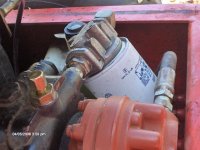AKKAMAAN
Veteran Member
Sorry that the thread got hi-jacked like this!!Maybe ther is an admin that can help us out!!
Yes that make some sense. The scandinavian logging equipment industry, where I am from, have to deal with a lot of problems.....break downs in the middle of nowhere etc. I think refilling fluid and repairing hoses is the two biggest problems with keeping system clean...many system I worked with have had pressurized tank (1-2 psi pressure valve in breather filter), refill of fluid thru QC thru return filter, pumping direct from oil barrel, vacuum pump to limit spill when reparing hoses etc. Diesel powered engine heaters that also warm up the hydraulic liquid in the tank....But I have barely seen a suction strainer and never a suction filter with by-pass....probobly because I have been on the 63rd degree latitude with temps zubzero for 5 months a year...LOL..If you have to fire up a piece of logging equipment at minus 30, you might have to remove all strainers and filters out from the suction line.....
Anyway, this new way of thinking is interesting to hear....
I still wonder what the pressure setting is on that suction filter by-pass valve....can't be more than 1-2 psi.... ???
Thank you Wayne for commenting on this!!Wayne County Hose said:They told me that they are way more concerned with contaminants entering the pumps than getting into the tank. Stuff getting into the tank, via the breather or from added oil, is a much larger concern than contaminants entering the tank from the rest of the system. The machines over time have needed to be more compact and more powerful. There is only one way to accomplish both, more hydraulic pressure. The way they wanted to increase hydraulic pressure and efficiencies is by tightening up the tolerances. So now, those little particles in the air that enter through the breather everytime a cylinder is filled with oil are in the hydraulic oil. The old way, the oil had to circulate through the entire system until it got to the filter. By placing the filter in the suction side, they have the filtering they need with the tighter tolerances in the pumps, valves, and other components.
Yes that make some sense. The scandinavian logging equipment industry, where I am from, have to deal with a lot of problems.....break downs in the middle of nowhere etc. I think refilling fluid and repairing hoses is the two biggest problems with keeping system clean...many system I worked with have had pressurized tank (1-2 psi pressure valve in breather filter), refill of fluid thru QC thru return filter, pumping direct from oil barrel, vacuum pump to limit spill when reparing hoses etc. Diesel powered engine heaters that also warm up the hydraulic liquid in the tank....But I have barely seen a suction strainer and never a suction filter with by-pass....probobly because I have been on the 63rd degree latitude with temps zubzero for 5 months a year...LOL..If you have to fire up a piece of logging equipment at minus 30, you might have to remove all strainers and filters out from the suction line.....
Anyway, this new way of thinking is interesting to hear....
I still wonder what the pressure setting is on that suction filter by-pass valve....can't be more than 1-2 psi.... ???

